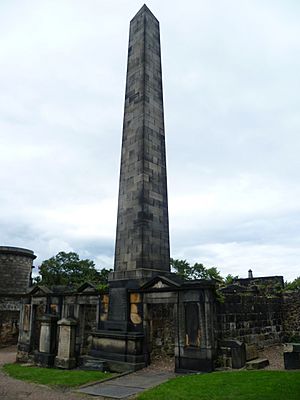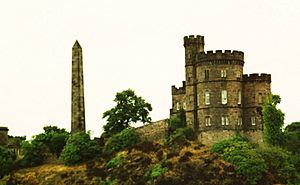Political Martyrs' Monument facts for kids
The Political Martyrs Monument is a tall stone monument located on Calton Hill in Edinburgh, Scotland. It stands in the Old Calton Burial Ground and was built in 1844. This monument remembers five brave people who wanted to change laws and make things fairer in the late 1700s and early 1800s. It was designed by an architect named Thomas Hamilton. The monument is about 90 feet (27 meters) tall and is made of strong sandstone blocks. It is a very important historical site.
Contents
Who the Monument Remembers
The monument honors five men who believed in making government fairer for everyone. They were:
- Thomas Muir
- Thomas Fyshe Palmer
- William Skirving
- Maurice Margarot
- Joseph Gerrald
These men were called "martyrs" because they faced serious trouble for their beliefs. The monument was put up by people who supported their ideas about changing laws in England and Scotland.
Messages on the Monument
The monument has special messages carved into its stone. One side lists the names of the five men. Another side shares powerful words from two of them.
One message is from Thomas Muir, spoken in 1793: "I have given my life to help the people. It is a good cause—it will win in the end—it will finally succeed."
Another message is from William Skirving, spoken in 1794: "I know that what has been decided these two days will be judged again."
These words show how strongly they believed in their cause, even when facing difficulties.
Building the Monument
Why it was Built
In 1837, a politician named Joseph Hume wanted to create a monument for these five men. He started a group in London to collect money from the public to build it. They decided that Edinburgh would be the best place for the monument.
William Tait, a publisher from Edinburgh, asked the city's leader, the Lord Provost of Edinburgh, if land could be used on Calton Hill for this special purpose.
Laying the Foundation Stone
The first stone of the monument was placed on August 21, 1844. About 3,000 people came to watch this important event. Calton Hill is home to many other monuments and memorials, making it a place of historical significance.
The monument was designed by Thomas Hamilton, who also designed other famous buildings on Calton Hill, like the old Royal High School.
Another Monument in London
In 1852, Joseph Hume also helped build a second monument to these men in Nunhead Cemetery in London. This monument is 33 feet (10 meters) tall.
The Five Reformers
The five men honored by the monument—two from Scotland and three from England—were involved in a movement to change how the government worked. They were inspired by new ideas from the French Revolution. They strongly supported the idea that more people should be able to vote and that elections should happen every year.
Because of their strong opinions, they were accused of speaking out against the government in 1793 and 1794. They were sentenced to be sent far away to a British colony called New South Wales (which is now part of Australia).
Most of the men traveled together on a ship called the Surprize. Joseph Gerrald left later on another ship.
What Happened to Them
Only Thomas Palmer and Maurice Margarot completed their full 14-year sentences and were eventually set free.
- Thomas Palmer stayed in New South Wales and started a successful business. He sadly passed away from a sickness while on a trading trip.
- Maurice Margarot left the colony when his sentence ended. He was the only one of the "Scottish Martyrs" to return to Britain.
- Thomas Muir managed to escape in early 1796. He secretly boarded an American ship and eventually made his way to France, where he passed away in 1799.
- Joseph Gerrald became very ill and passed away in New South Wales in 1796.
- William Skirving passed away just three days after Gerrald.
These men are remembered for their courage in fighting for what they believed was right, even when it meant facing great challenges.
Images for kids
-
The Monument on Calton Hill, next to the Governor's House
-
The monument in Nunhead Cemetery, London






